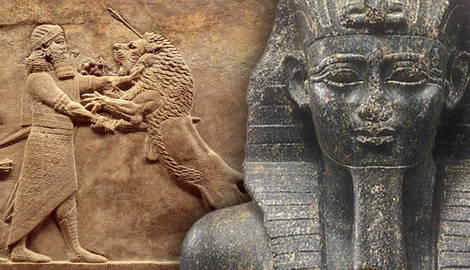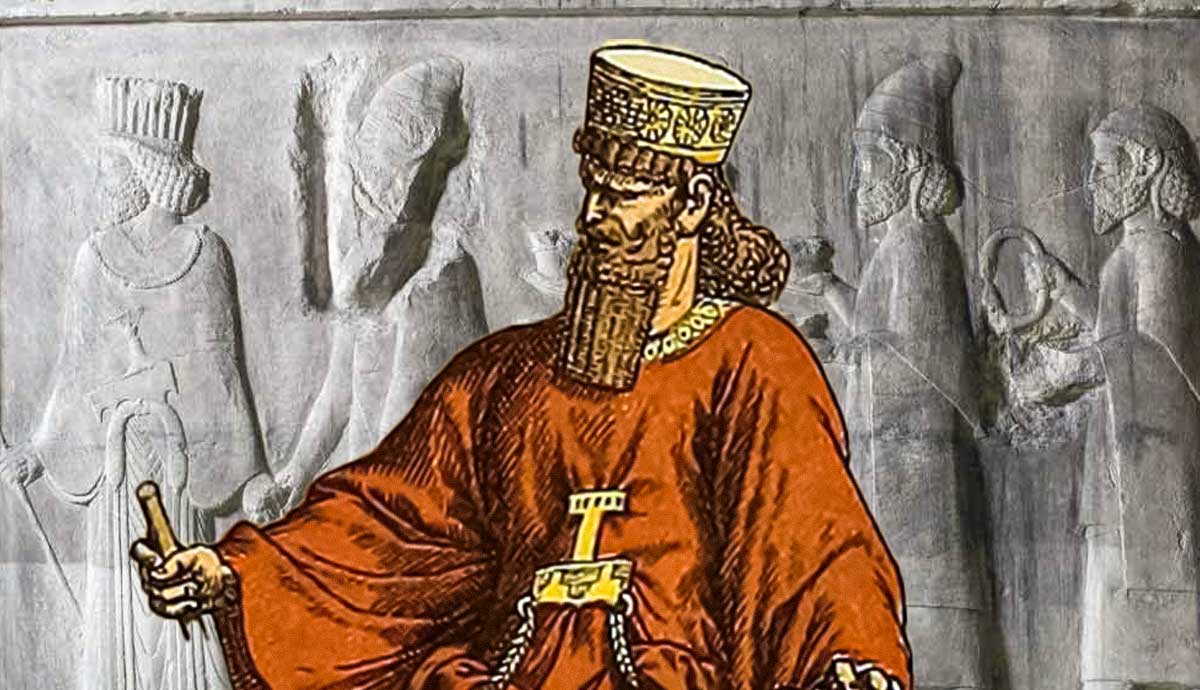
When the Neo-Assyrian Empire set its sites on conquering Egypt, the country was in its Third Intermediate Period. Egypt was divided and ruled by regional kings and under Kushite influence. While the Assyrians were successful in their conquest of Egypt in the 7th century BCE, their reliance on vassal kings rather than direct rule created a situation that allowed one Egyptian king to unite Egypt under his rule, ushering in Egypt’s Late Period. While the new Egyptian kings were Assyrian allies, their power grew as the Neo-Assyrian Empire crumbled.
Before the Storm

Before Assyria’s conquest of Egypt, there was a period of tense relations between Egypt and Assyria, and between Egypt and Kush. Egypt’s 25th dynasty, the final dynasty of the Third Intermediate Period, was often called the Nubian Dynasty. The Kushite Empire was founded when Piye, King of Kush, conquered Egypt 744 BCE.
As Upper Egypt’s competing kings bickered among themselves, Piye seized the opportunity to invade. He conquered Hermopolis and Memphis, and had multiple regional Egyptian kings swear allegiance to him. After he subjugated vast amounts of Egypt, Piye attempted to gain a foothold in the Near East. In 720 BCE Philistia and Gaza rebelled against Assyria. The opportunistic Piye sent an army to aid them, but Sargon II crushed the uprising.
During the reign of the Assyrian king Sennacherib, tension between Egypt and the Levant continued. In 705 BCE, Hezekiah, King of Judah ceased paying tax to Assyria and conspired with other anti-Assyrian kings in the area. Hezekiah proceeded to launch assaults against Philistine kings loyal to Assyria. By 701 BCE, Egypt and the four kingdoms of Judah, Sidon, Ascalon, and Ekron established an alliance against Assyria. A displeased Sennacherib marched against the rebels and conquered Sidon, Ascalon, and Ekron.
His army continued into the Levant and destroyed many cities and settlements on his way to Judah’s capital, Jerusalem. However, the Assyrian king was unable to conquer Jerusalem. Sennacherib’s accounts say that Judah paid him tribute and he left the city. The Bible states that King Hezekiah prayed to God and an angel killed thousands of Assyrian soldiers.
King Esarhaddon

Esarhaddon came to power in Assyria after his father, Sennacherib, was murdered in 681 BCE. The subsequent chaos in the Assyrian court led to unrest across the empire, and many vassal states took the opportunity to break free. One of these states was Sidon, which had been made a vassal under Sennacherib, but was reduced to an Assyrian province after Esarhaddon quashed their most recent rebellion.
By 677 BCE, Esarhaddon campaigned up to the Brook of Egypt (the southernmost area of the Levant before Egypt) to defeat Arab tribes around the Dead Sea and subdue rebelling kingdoms such as Sidon. In the following years, Esarhaddon campaigned in Urartu, Anatolia, and against the Elamite-Babylonians.
In 673 BCE, Esarhaddon turned his attention to Egypt, which had supported Assyrian rebels for years. He hoped to teach them a lesson. His first assault against Egypt proved one of Assyria’s worst defeats ever. The forces of the Nubian pharaoh Taharqa vanquished the Assyrians, who were seemingly exhausted from Esarhaddon’s desire to march quickly. The Assyrians abandoned the plan of conquering Egypt and returned to Nineveh. Esarhaddon used this period to rethink his attack.
When he marched on Egypt again in 671 BCE he stopped in the city of Harran, on the south-eastern edge of modern-day Turkey. Here the Assyrian king received a prophecy that foretold his attack on Egypt would be a success.
This time Esarhaddon’s forces were larger, marched slower, and were victorious in the first clash. Subsequently, Esarhaddon devastated Memphis. Although Taharqa was able to escape, the Assyrians captured many members of the Egyptian royal family, including the pharaoh’s son and wife, who were taken back to Assyria as hostages.
Esarhaddon had a victory stele commissioned showing Taharqa’s young son Ushankhuru in bondage. The stele may also show Taharqa, but the identity of the second figure is debated and may also be Baal I, King of Tyre. In the aftermath of Esarhaddon’s conquest, he reconfigured the government of Egypt and appointed men who supported Assyria to important positions.
Ascension of Ashurbanipal

Esarhaddon left Egypt in the hands of his chosen vassals, unknowingly sowing seeds of further instability. The Assyrian king had effectively expelled many of the ruling Kushites and Nubians from Lower Egypt, which had been incorporated into the Kushite Empire less than a century earlier. But the population was restless for their independence from both Kush and Assyria.
After Esarhaddon left, Taharqa returned to Lower Egypt, took Memphis, and forced the officials appointed by Esarhaddon to abscond in 669 BCE. Esarhaddon almost immediately embarked on a new offensive campaign against Egypt, but swiftly on the way there. Esarhaddon’s two sons rose to power. Shamash-shum-ukin ascended as king in Babylon and his other son Ashurbanipal assumed the throne of Assyria.
Ashurbanipal resumed his father’s assault on Egypt with vigor. He chased Taharqa to Thebes and sacked many cities on his journey there. But he failed to organize direct Assyrian rule and again relied on vassal kingships. The only place Ashurbanipal came to and did not destroy was Sais, as its ruler, Necho I, had maintained loyalty to Assyria. Furthermore, Ashurbanipal returned Necho I’s son Psamtik, who had been educated at court in Nineveh under Esarhaddon, to Egypt.
Later the Assyrian king learned of a plot between some vassal kings and Taharqa, which included Necho I. The vassal kings implicated were executed, except for Necho I, which historians theorize was due to Ashurbanipal’s hope that Necho I would view him as benevolent. Additionally, there were now far fewer ruling vassal kings, and this would have given Necho I greater power, which in turn would have bolstered competition between Sais and the Kushites for control. Therefore, it is likely Ashurbanipal spared Necho I to further his own purposes in Egypt, rather than as an act of goodwill.
Sack of Thebes

Taharqa died in Thebes in 664 BCE and Tatanami, Taharqa’s nephew and son of the preceding king, Shabaka, assumed control of Kush. Upon ascension, Tatanami marched up from Nubia and took multiple cities on his journey to Memphis, where he met Necho I and his Egyptian-Assyrian troops.
The coalition was victorious, but the triumph was bittersweet. Necho I was killed in the battle. His son succeeded him and became Psamtik I of Sais. The victory was further soured because the Egyptians preferred Nubian rule to Assyrian domination. Psamtik I was forced to flee back to Assyria.
Psamtik I returned to Egypt with Ashurbanipal and a large army around 40 days later. Tatanami escaped to Thebes, but the coalition followed him and sacked the city. Evidence for the sack of Thebes is controversial. Ashurbanipal states that he deported vast numbers of inhabitants and seized a colossal amount of plunder. But records from the city show that most of the officials who were in power before the sacking remained in their positions afterward. Nevertheless, the significance of the sack of Thebes was monumental. The attack is discussed in the Bible in both the Book of Isaiah and the Book of Nahum, which both attest to Assyria’s cruel treatment of Thebes’ inhabitants.
Rise of Psamtik I

During the attack, Tatanami escaped once more, this time further south to Nubia. Tatanami would never again pose a threat to Lower Egypt, and neither would any other Kushite king. Tatanami died around 653 BCE and was buried in El-Kurru, the Kushite royal cemetery. The sack of Thebes effectively led to the end of Kushite rule of Egypt and directly led to the establishment of the 26th dynasty.
Psamtik I ruled by the Assyrian arrangements as part of the Egyptian Dodecharcy, the system of government in Egypt established when Necho I was king. Twelve regional kings ruled over the Nile Delta, with the king of Sais as the most powerful. But conflict soon erupted between the kings. According to Herodotus, it started when Psamtik I fulfilled a prophecy that would allow him to become king of all Egypt. In retaliation, the other kings banished Psamtik I. While he was absent, Psamtik I received another prophecy in Buto, which stated he would have his revenge with help from bronze men of the sea.
By 662 BCE, Psamtik I consorted with King Gyges of Lydia, who sent mercenaries to aid the Egyptian king to take back Memphis. He also likely received support from Arabs from the Sinai Peninsula. With their help, Psamtik I successfully regained his territory, and many of the opposing kings disappeared into Libya.
Back in power, Psamtik I placed his military forces at various strategic points to protect against potential attack from the Kushites. By 657 BCE, Psamtik I was the sole ruler of the Nile Delta and had consolidated most of Lower Egypt into one state again. Then in 655 and 654 BCE, Psamtik successfully fought against Libyan tribes in the north of Egypt and stationed military units in the area. By his tenth regnal year, Psamtik I was fully in control of the whole of Egypt.
Assyrian-Egyptian Relations Before the Fall of Assyria

Historians often debate the matter of Assyria and Egypt’s relations during the rest of the reign of Ashurbanipal. It is clear that Psamtik I went against the Assyrian regime by initiating conflict with the other regional kings of the Egyptian Dodecharcy, whom Assyria had also put in power. However, Assyrian sources do not mention these events, and more importantly, Psamtik I never fought against Assyrian power. Furthermore, the Arabs of the Sinai Peninsula were another vassal state of Assyria. Their alliance with Psamtik I may have been brokered by Ashurbanipal.
Ashurbanipal may have had less than amicable relations with King Gyges of Lydia, because he refused a pact with Assyria, but the two nations never fought. Gyges had asked Assyria for help against the Cimmerians, but refused to pay tribute and therefore avoided becoming an Assyrian vassal. Nevertheless, when he fought the Cimmerians with no aid and won, Gyges still sent captives to Assyria.
Therefore, it appears that the alliance between Ashurbanipal and Psamtik I held up for the rest of the Assyrian king’s reign, and even extended into the reigns of his successors. After the death of Ashurbanipal in 631 BCE, Assyria fell into disarray. The following kings could not keep up with the vast empire Assyria had amassed and many vassals took the opportunity to establish their independence. The Scythians, for example, seized the chance to fill the power vacuum left by the Assyrians in the Levant. As they were expanding their territory in the Levant, Psamtik I met them and persuaded them to return home.
Psamtik I died in 610 BCE, but not before he had made conclusive efforts to assist Assyria’s efforts in the Levant against an affiliation of Babylonians, Medes, and Chaldeans. He was succeeded by his son Necho II, who continued to support Assyria in its period of rapid decline. The Egyptians were present at the Battle of Megiddo and Battle of Harran in 609 BCE, and the Battle of Carchemish in 605 BCE, on the Assyrian side.
Although the Egyptian-Assyrian efforts were futile and the Neo-Assyrian Empire collapsed, Necho II went on to have a successful reign. On his return from war in Mesopotamia in 605 BCE, he fought with the new Judean King, Jehoahaz, and took him back to Egypt as his prisoner. This is mentioned in the Book of Kings and the Book of Chronicles. He spent the rest of his reign fostering positive relations with areas of Anatolia and Greece. In the end, the Assyrian conquest of Egypt resulted in the growth of Egyptian power and security and a strong alliance until the end of the Neo-Assyrian Empire.










